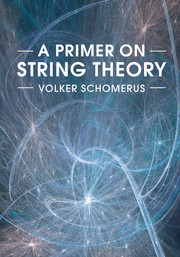Book contents
- Frontmatter
- Contents
- Preface
- 1 Historical Introduction and Overview
- Part I Strings in Flat Backgrounds
- Part II Strings in Curved Backgrounds
- 13 Introduction to Conformal Field Theory
- 14 Modular Invariants and Orbifolds
- 15 Closed Strings on the 3-Sphere
- 16 CALABI-YAU Spaces
- 17 CALABI-YAU Compactifications
- 18 String Dualities
- 19 Gauge/String Dualities
- 20 AdS/CFT Correspondence
- Bibliography
- Index
17 - CALABI-YAU Compactifications
from Part II - Strings in Curved Backgrounds
Published online by Cambridge University Press: 05 July 2017
- Frontmatter
- Contents
- Preface
- 1 Historical Introduction and Overview
- Part I Strings in Flat Backgrounds
- Part II Strings in Curved Backgrounds
- 13 Introduction to Conformal Field Theory
- 14 Modular Invariants and Orbifolds
- 15 Closed Strings on the 3-Sphere
- 16 CALABI-YAU Spaces
- 17 CALABI-YAU Compactifications
- 18 String Dualities
- 19 Gauge/String Dualities
- 20 AdS/CFT Correspondence
- Bibliography
- Index
Summary
In the last chapter we have sketched some results from mathematics. We looked at complex manifolds with Hermitian metric and then imposed the KÄHLER condition (16.16) without any further motivation. After combining the KÄHLER condition with RICCI flatness we ended up with the class of CALABI-YAU manifolds. The results of mathematics ensure that the HODGE diamond of a CALABI-YAU manifold has a very special form. It contains only two non-trivial entries, h1,1 = h2,2 and h1,2 = h2,1. All other entries are either zero or one; see Figure 16.24. Let us finally also recall that the numbers hp,q count the number of harmonic (p, q) forms on the manifold.
We made very little attempt to connect the KÄHLER condition and its various consequences to our goal, namely to construct 4-dimensional string compactifications with N=2 supersymmetry in space-time. The aim of the present chapter is to fill this gap. In the first half we shall show that the massless spectrum of type II compactifications on CALABI-YAU manifolds is organized in multiplets of the 4-dimensional N=2 POINCARÉ superalgebra. The second part is devoted to a deeper understanding of the KÄHLER condition. Our strategy is to connect this condition to the GSO projection in curved backgrounds.
CALABI-YAU Spaces and 4D Supersymmetry
We now want to investigate how the 4-dimensional low-energy effective field theories depend on the CALABI-YAU space we compactify our type IIA/B string theory on. As we mentioned before, the resulting gravity theories come with an N=2 supersymmetry in four dimensions, i.e. they possess eight supercharges. Our main goal is to determine the type and number of massless N=2 supermultiplets that appear in a given compactification.
This needs a bit of preparation. To begin, let us recall the bosonic content of the relevant supermultiplets. As in all massless supermultiplets, half of the supercharges decouple. Hence, we are left with four supercharges that we combine into two creation and two annihilation operators. The two fermionic creation operators carry helicity. With this in mind we can easily determine the bosonic content of N=2 supermultiplets. We shall need
- Type
- Chapter
- Information
- A Primer on String Theory , pp. 170 - 180Publisher: Cambridge University PressPrint publication year: 2017



